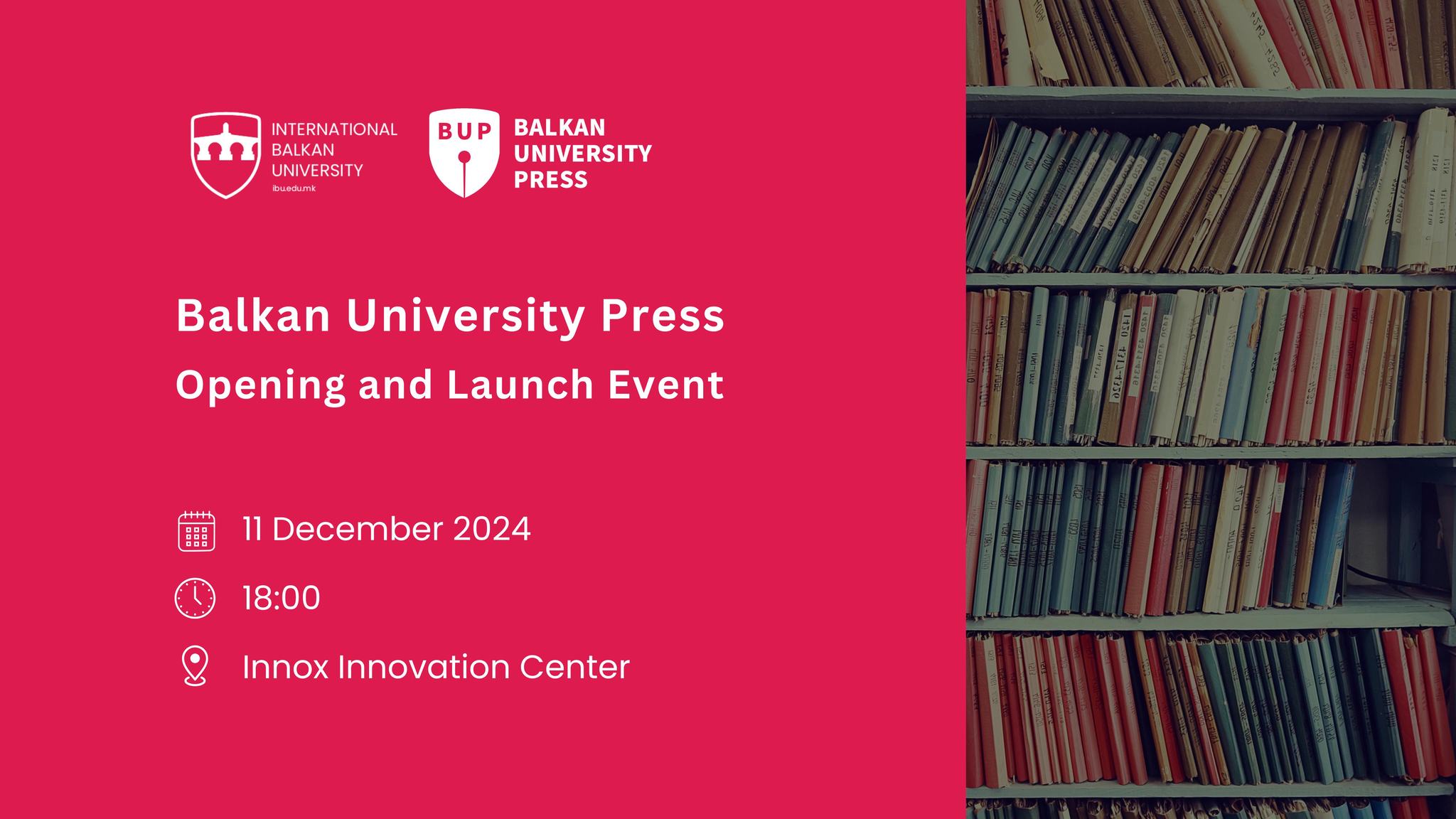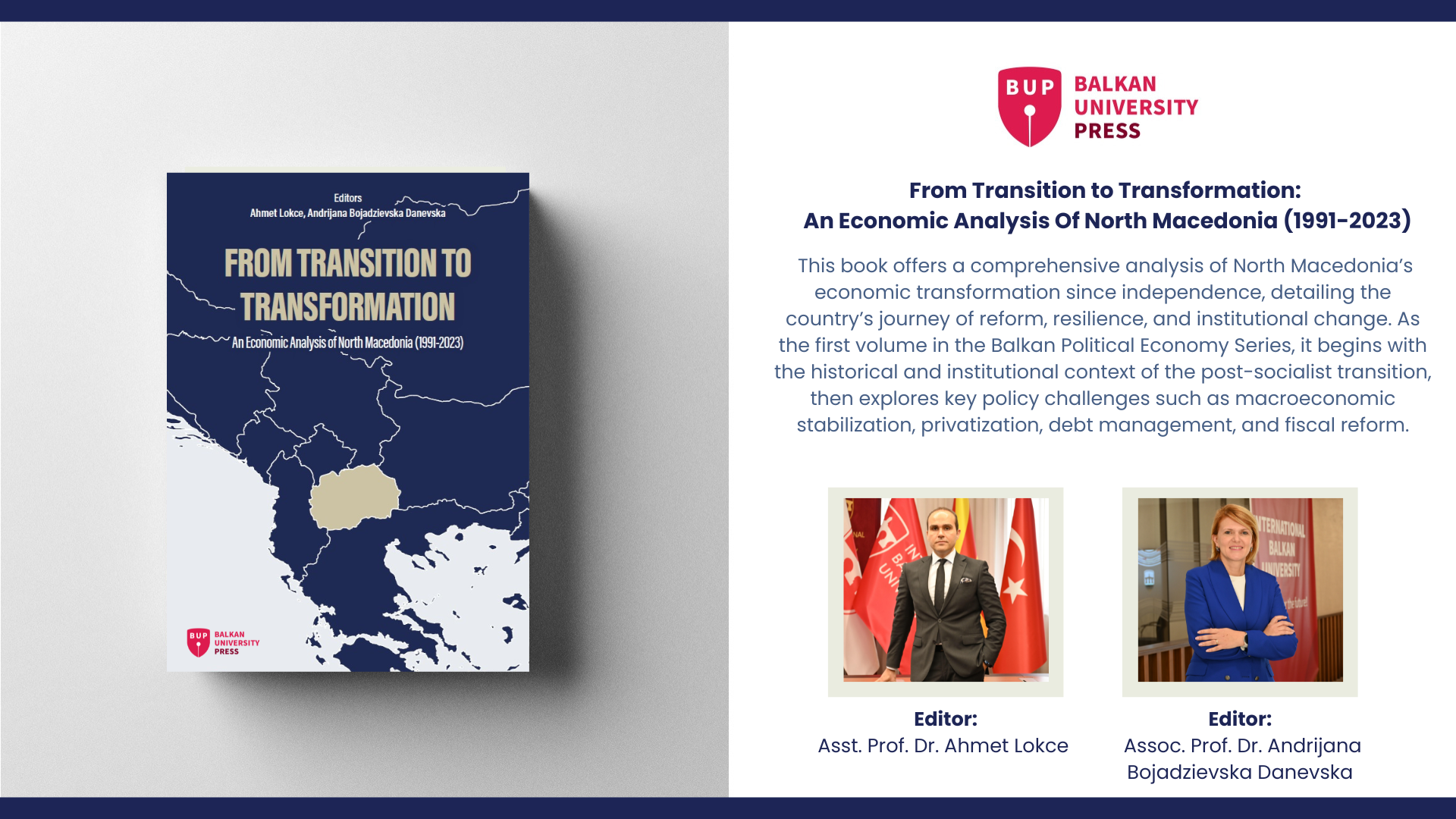
BUP Interview with Prof. Shener Bilalli
BUP: Tell us more about yourself and what motivated you to explore the representation of the Ottoman Empire in Macedonian textbooks.
SB: I was born in 1980 in the village of Tearce, North Macedonia. After completing my primary, secondary, and high school education in North Macedonia, I earned the right to study at Gazi University in the Republic of Turkey during the 1997-98 academic year. I completed my bachelor's and two master's degrees in Ankara before returning to my homeland. I completed my doctorate at the National Institute of Ss. Cyril and Methodius State University in North Macedonia. Since 2008, from its inception, I have continued my administrative and academic career at the International Balkan University in Skopje.
I am a scholar and researcher in the fields of history, education, political sciences, and social sciences, particularly in the context of the Balkans. My research often focuses on issues related to historical narratives, identity, and the portrayal of ethnic and political groups in educational systems. My interest in the representation of the Ottoman Empire in Macedonian textbooks is part of a broader exploration into how history is taught and how it shapes collective memory and national identity, particularly in multi-ethnic societies like North Macedonia.
My motivation to examine the Ottoman Empire's representation in Macedonian textbooks is driven by the complex historical relationship between the region and the Empire, which ruled over the Balkans for centuries. The way this period is depicted in textbooks can significantly influence how students understand their nation's history, identity, and relationships with other ethnic groups. In North Macedonia, a country with a significant ethnic Albanian and Turkish minority, the portrayal of the Ottoman period can affect inter-ethnic relations and the broader national narrative.
By investigating this topic, I aimed to uncover biases, omissions, or misrepresentations in educational materials that might contribute to nationalistic or one-sided views of history. My research helps promote a more balanced and inclusive understanding of the past, which is especially important in regions where historical narratives can fuel contemporary political and social tensions.
BUP: How has the image of the Ottoman Empire in Macedonian textbooks evolved?
SB: After Macedonia gained independence in 1991, the depiction of the Ottoman Empire in textbooks reflected the nation's search for a cohesive national identity. The early post-independence textbooks tended to emphasize Macedonian victimhood and resistance to Ottoman rule, reinforcing a narrative of national liberation.
In more recent years, as I have explored, the representation of the Ottoman Empire in Macedonian textbooks has become more balanced. While the narrative of resistance and struggle for independence remains central, there has been an effort to acknowledge the complexity of Ottoman rule. This includes recognizing the multi-ethnic nature of the empire, its contributions to culture, architecture, and the legal system, as well as the relatively peaceful coexistence of different ethnic and religious groups under Ottoman rule for extended periods.
My work reveals how textbooks now attempt to present a more inclusive history, partially in response to the country’s diverse population and the need for reconciliation between different ethnic groups. However, challenges remain as competing nationalisms and historical narratives continue to influence how the Ottoman past is interpreted.
BUP: How do you believe the portrayal of the Ottoman Empire in these textbooks has shaped national identity or collective memory in Macedonia?
SB: My analysis of how the portrayal of the Ottoman Empire in Macedonian textbooks has shaped national identity and collective memory offers significant insights into the complex relationship between historical narratives and identity formation in the country. Macedonia’s multi-ethnic composition, with significant Albanian and Turkish minorities, makes the representation of the Ottoman period a key factor in shaping both national identity and inter-ethnic relations.
Macedonian textbooks, especially after independence in 1991, often depicted the Ottoman Empire through a lens of oppression and struggle, emphasizing the role of the Ottoman period as a time of foreign domination. This portrayal contributed to a national narrative centered around resistance, struggle, and eventual liberation, which has become a key part of the collective memory of ethnic Macedonians. By framing the Ottoman Empire as the "other," it helped solidify the Macedonian identity in opposition to this historical period. This emphasis on resistance likely reinforced the notion of an ethnically Macedonian national identity, particularly for the Slavic-speaking majority, while sometimes marginalizing the role and historical experiences of non-Slavic groups like Albanians and Turks, many of whom have different connections to the Ottoman past.
The portrayal of the Ottoman Empire also plays a key role in how collective memory is formed in Macedonia. Historical narratives in textbooks help shape how successive generations understand their past and their place in the world. A narrative that focuses exclusively on resistance and victimhood may cultivate a sense of historical grievance, which can influence how Macedonians see themselves in relation to their neighbors and the world at large. However, as the narrative evolves to include a more comprehensive view of the Ottoman Empire, collective memory can shift toward a more nuanced understanding of the past. This could lead to a more balanced approach to both internal and external relations, where the Ottoman period is seen not only as a time of subjugation but also as a period that contributed to the cultural and historical development of the region.
BUP: What key themes or narratives tend to dominate the depiction of the Ottoman period in these educational materials?
SB: According to my research, several key themes and narratives tend to dominate the depiction of the Ottoman period in Macedonian educational materials. One of the most prominent narratives in Macedonian textbooks is the portrayal of the Ottoman Empire as an oppressive force that subjugated the local population. This theme often emphasizes the hardship and suffering experienced by the ethnic Macedonians during Ottoman rule, highlighting the loss of autonomy, exploitation, and harsh treatment by Ottoman authorities.
The focus on oppression often includes references to heavy taxation (such as the devşirme system, or the "blood tax"), restrictions on religious freedoms, and the social and political marginalization of non-Muslims. This narrative reinforces a sense of victimhood and positions the Ottoman Empire as an alien force that disrupted the natural development of the region.
A related theme that often dominates is the idea of resistance against Ottoman rule. Macedonian textbooks frequently highlight moments of rebellion, uprisings, and the eventual national liberation movements that led to the region’s independence from Ottoman control. Heroes of resistance, both historical figures and broader nationalist movements, are emphasized as symbols of the Macedonian people's enduring desire for freedom.
Another key narrative is economic exploitation. This narrative often includes references to the confiscation of lands, unequal treatment of Christian subjects, and the overall stagnation or decline of local economies under Ottoman control. The focus on economic exploitation reinforces the idea that the Ottoman period was a time of regression for Macedonia, rather than a time of cultural or economic flourishing.
There is also a lack of emphasis on the multi-ethnic and multicultural aspects of the Ottoman Empire. While the Ottoman Empire was a diverse, multi-ethnic state that allowed for various ethnic and religious groups to coexist under the millet system, Macedonian textbooks may downplay this complexity.
BUP: How do you think the current portrayal of the Ottoman Empire influences students’ understanding of their country's history and its role in the broader Balkan region?
SB: The way the Ottoman period is presented in educational materials has profound implications for shaping students' perspectives on national identity, inter-ethnic relations, and Macedonia’s historical and geopolitical place in the Balkans. The dominant narrative of oppression and resistance against Ottoman rule helps to shape a strong sense of Macedonian national identity. By emphasizing the struggle for independence from a powerful empire, students are encouraged to view their country’s history as one of endurance and resilience. This portrayal fosters national pride but may also lead students to see the Ottoman period primarily as a dark chapter of foreign domination, which influences how they perceive external influences and the legacy of empires in their country’s development. In addition, the negative portrayal of the Ottoman Empire might limit students' appreciation of the region’s multi-ethnic and multicultural history. The Ottoman Empire was a complex, multi-ethnic entity that governed diverse peoples, including Slavs, Albanians, Turks, Greeks, and others. If textbooks evolve toward a more inclusive and nuanced portrayal of the Ottoman Empire, students may develop a greater appreciation for the shared cultural and historical heritage of the Balkans.
BUP: What recommendations would you give to textbook authors or policymakers to ensure a more balanced portrayal of the Ottoman era in Macedonia?
SB: Textbooks should provide a more nuanced and multi-dimensional portrayal of the Ottoman Empire. Instead of focusing solely on oppression and resistance, they should include diverse aspects of Ottoman governance, culture, and society. This includes acknowledging both the challenges and contributions of Ottoman rule—such as advancements in architecture, trade, urbanization, legal systems, and cultural exchange. Furthermore, Macedonian textbooks should better emphasize the multi-ethnic and multi-religious nature of the Ottoman Empire.
While it is important to recognize the challenges and hardships of Ottoman rule, textbooks should also acknowledge the positive contributions made during this period. This could include the architectural legacy (such as mosques, bridges, and markets), advancements in trade and commerce, and the development of urban centers. Another key recommendation would be to include a discussion of the long-term impacts of Ottoman rule on Macedonia and the broader Balkan region. Textbooks should explore not just the immediate consequences of Ottoman governance but also its lasting influence on the political, social, and cultural development of the region. By examining the legacy of the Ottoman Empire in areas such as law, urbanization, and cultural exchange, students can gain a better understanding of how historical periods continue to shape the present. This broader perspective can help students see the Ottoman era as a complex and multifaceted period, rather than simply as a time of domination and resistance.


















































.png)



.png)

.png)